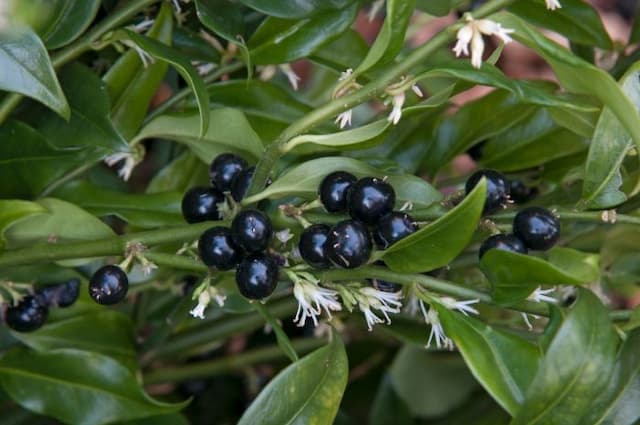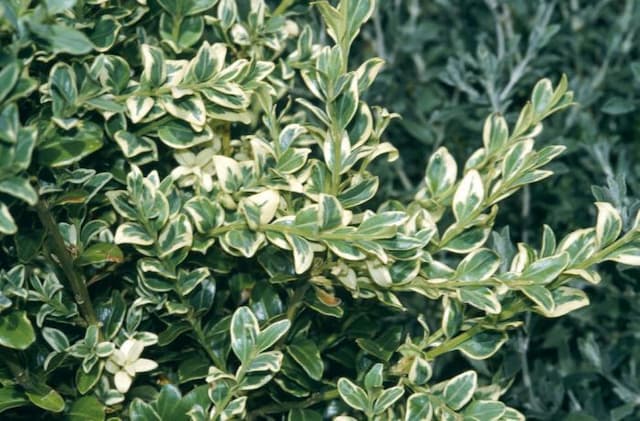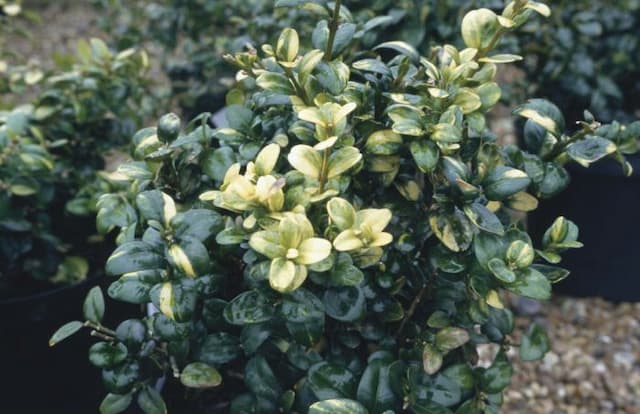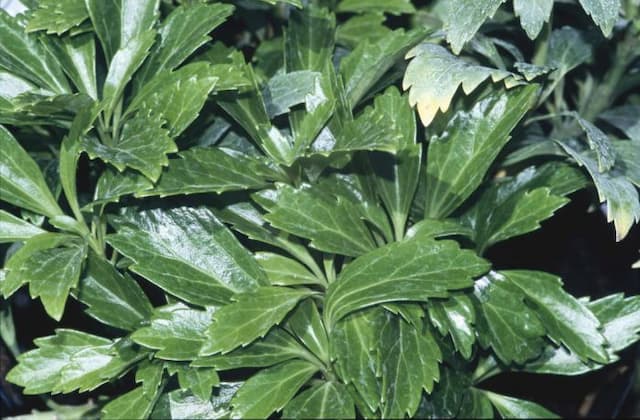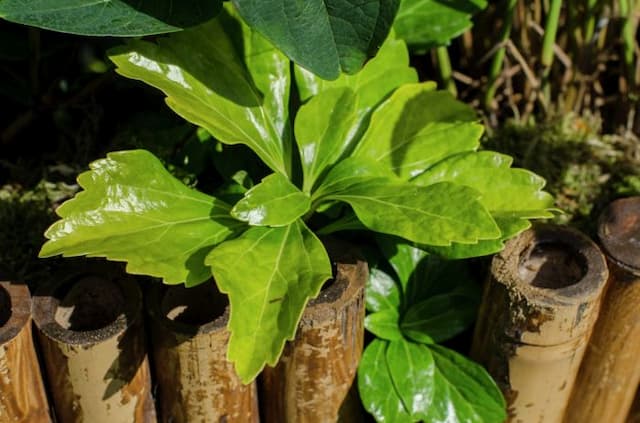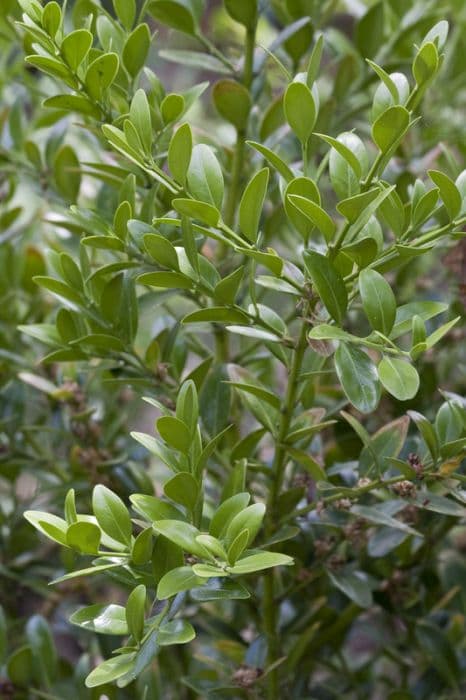Sweetbox Sarcococca hookeriana

ABOUT
The plant commonly known as Sweet Box or Christmas Box is a bushy evergreen with glossy dark green leaves that persist throughout the year. The leaves are lance-shaped and can have a slightly leathery texture, presenting a lush appearance. During late winter to early spring, it produces small, often inconspicuous creamy-white flowers that are highly fragrant; the scent can easily fill the surrounding area. These tiny blooms sometimes go unnoticed because they blend into the dense foliage. Following the flowering period, Sweet Box may produce black berry-like fruits that add interest to its appearance, although the primary allure of this plant tends to be its sweet-smelling flowers and rich green foliage that can provide a backdrop for other plants in a garden setting.
About this plant
 Names
NamesFamily
Buxaceae
Synonyms
Sweet Box, Christmas Box, Himalayan Sweet Box, Hooker's Sweet Box
Common names
Sarcococca ruscifolia var. chinensis, Sarcococca ruscifolia var. hookeriana, Sarcococca hookeriana var. digyna, Sarcococca hookeriana var. humilis.
 Toxicity
ToxicityTo humans
Sweet box (Sarcococca hookeriana) is not considered highly toxic to humans. However, as with many plants, ingestion, particularly of the berries, could potentially lead to gastrointestinal upset, including nausea, vomiting, and diarrhea. It is generally advised to avoid eating any part of ornamental plants due to potential adverse effects.
To pets
Sweet box (Sarcococca hookeriana) is also not known to be highly toxic to pets. If ingested by cats, dogs, or other household pets, the most common symptoms might include mild gastrointestinal upset, such as vomiting or diarrhea. Although serious toxicity is rare, it is still recommended to keep an eye on pets and prevent them from consuming plant material.
 Characteristics
CharacteristicsLife cycle
Perennials
Foliage type
Evergreen
Color of leaves
Green
Flower color
White
Height
3-5 feet (0.91-1.52 meters)
Spread
3-5 feet (0.91-1.52 meters)
Plant type
Shrub
Hardiness zones
6
Native area
Himalayas
Benefits
 General Benefits
General Benefits- Low Maintenance: Sarcococca hookeriana, commonly known as sweet box, is easy to care for and does not require frequent attention once established.
- Evergreen Foliage: The sweet box retains its glossy green leaves throughout the year, providing constant visual interest in the garden.
- Fragrant Flowers: The plant produces small, fragrant white flowers in winter when few other plants are in bloom, adding a pleasant scent to the garden.
- Drought Tolerance: Once established, sweet box is relatively drought-tolerant, making it suitable for gardens with limited water resources.
- Shade Tolerance: Sweet box thrives in partial to full shade conditions, making it an ideal choice for understory plantings or shady gardens.
- Erosion Control: Its dense root system helps to stabilize the soil and prevent erosion on slopes or in areas prone to soil loss.
- Wildlife Friendly: The flowers attract pollinators like bees, and the berries can provide food for birds during the winter months.
- Decorative Berries: Sweet box bears ornamental berries that can range in color from red to black, adding further interest to the winter landscape.
- Compact Growth: This plant generally remains compact, making it suitable for smaller gardens or as ground cover without overtaking other plants.
- Versatile Usage: Sweet box can be used in a variety of garden settings, including borders, containers, and as a low hedging plant.
 Medical Properties
Medical PropertiesThis plant is not used for medical purposes.
 Air-purifying Qualities
Air-purifying QualitiesThis plant is not specifically known for air purifying qualities.
 Other Uses
Other Uses- Sweet Box can be used for winter interest in gardens due to its evergreen foliage and fragrant flowers which bloom during late winter.
- The dense habit of Sweet Box provides excellent ground cover in shady areas, helping to suppress weeds and minimize garden maintenance.
- Its berries can be a source of winter food for birds, though they are not a primary food source.
- Sweet Box's wood is sometimes used in small woodworking projects, particularly for inlays and intricate carving, due to its fine grain.
- The robust nature of Sweet Box makes it an ideal candidate for use in urban landscaping, where it can thrive despite pollution and limited soil conditions.
- This plant is often used to create a low, informal hedge bordering walkways or defining garden spaces due to its compact growth habit.
- Sweet Box can be utilized in slope stabilization, its roots can help to reduce soil erosion on banks and slopes.
- When planted en masse, Sweet Box can be used to add texture and variegation to the garden, especially given its glossy leaves.
- It is used in perfumery to create fragrances that require a rich, heavy, sweet and slightly spicy scent, similar to that of its flowers.
- Sweet Box can also serve as a companion plant, its tolerance for deep shade providing the perfect understory to taller shade-loving shrubs.
Interesting Facts
 Feng Shui
Feng ShuiSweet Box is not used in Feng Shui practice.
 Zodiac Sign Compitability
Zodiac Sign CompitabilitySweet Box is not used in astrology practice.
 Plant Symbolism
Plant Symbolism- Persistence and Resilience: As a plant that thrives in challenging conditions, Sarcococca hookeriana, commonly known as Sweet Box or Christmas Box, symbolizes the ability to persist and to overcome adversity.
- Protection: The robust nature of Sweet Box, with its evergreen foliage, suggests a symbol of protection and shelter throughout the year.
- Peace and Tranquility: Sweet Box emits a pleasant fragrance, especially in winter, symbolizing peace and tranquility in the home or garden where it is planted.
- Low-Profile Elegance: Known for its subtle beauty and not being a showy plant, Sweet Box represents understated elegance and a grounded sense of presence.
 Water
WaterSweet Box prefers consistently moist soil, so water it regularly, particularly during dry spells. Depending on rainfall and soil drainage, water Sweet Box with approximately one gallon per week to maintain adequate moisture levels. During the warmer months, you might need to water twice a week if the soil dries out quickly. Reduce watering in the winter when the plant is not actively growing, but ensure the soil does not become completely dry.
 Light
LightSweet Box thrives best in partial to full shade, making it suitable for shady spots in the garden where many other plants might struggle. It tolerates deep shade but also grows well in dappled sunlight under larger trees or on the north side of buildings where it receives limited direct sun.
 Temperature
TemperatureSweet Box is hardy and can handle a range of temperatures, generally preferring to grow in conditions between 60 and 75 degrees Fahrenheit. It can survive minimal temperatures down to about 0 degrees Fahrenheit, but it is not suited for extremely hot climates where temperatures consistently exceed 90 degrees Fahrenheit.
 Pruning
PruningPruning Sweet Box is mainly done to maintain its shape or remove damaged branches. Pruning should be completed in late winter or early spring before new growth starts. This plant does not require heavy pruning, so it's typically enough just to tidy up the plant annually. If needed, you can also remove any undesirably long or wayward branches to keep the plant neat.
 Cleaning
CleaningAs needed
 Soil
SoilSweet Box prefers well-drained soil with a mixture of two parts loam, one part peat or compost, and one part sand to ensure proper drainage, with an ideal pH of 5.5 to 6.5.
 Repotting
RepottingSweet Box should be repotted approximately every 2-3 years or when it has outgrown its current container.
 Humidity & Misting
Humidity & MistingSweet Box thrives in moderate to high humidity levels but is quite adaptable to less humid conditions typical of most home environments.
 Suitable locations
Suitable locationsIndoor
Keep Sweet Box in bright, indirect light and maintain moist soil.
Outdoor
Plant Sweet Box in semi-shade, sheltered from strong winds.
Hardiness zone
6-9 USDA
 Life cycle
Life cycleSarcococca hookeriana, commonly known as Sweet box or Christmas box, begins its life cycle as a seed that germinates in moist, well-drained soil, often in partial to full shade. After germination, the seedling develops into a young plant with a small set of true leaves, establishing its root system. As the plant matures, it forms dense, evergreen foliage and starts to spread through rhizomes, slowly expanding its presence in the garden. Once mature, usually after a few years, Sweet box produces small, fragrant white flowers in late winter to early spring, which are pollinated by insects. Following flowering, the plant develops small black berry-like fruits that contain seeds, ready to disperse and start new plants. The shrub then enters a period of dormancy during the colder months, conserving energy for the next growth cycle.
 Propogation
PropogationPropogation time
Early Spring
Propogation: For Sweet Box (Sarcococca hookeriana), the most popular method of propagation is by semi-ripe cuttings. This process typically takes place in late summer. To propagate by cuttings, one would select a healthy, semi-ripe shoot and cut a section that is about 4 to 6 inches (10 to 15 centimeters) long. The leaves on the lower half of the cutting should be removed, and the cut end can be dipped in rooting hormone to encourage root development. The prepared cutting is then inserted into a pot filled with a mixture of peat and perlite or sand to ensure good drainage. The pot should be kept in light shade and maintained at a consistent moisture level until roots have developed, which can be checked by gently tugging on the cutting after a few weeks to feel for resistance.
